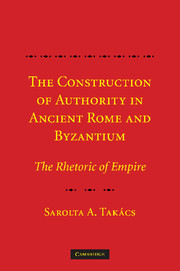Book contents
CHAPTER FOUR - The Power of Rhetoric
Published online by Cambridge University Press: 15 October 2009
Summary
The Last Roman Emperor: Justinian
In the transition from a pagan to a Christian empire, three important shifts occurred with respect to the state's highest authority, the emperor. First, Christian martyrs sacrificed their lives for their belief in the Christian God, displaying virtuous behavior similar to that of Roman soldiers and successful gladiators before them. Their willingness to die garnered them everlasting honor and remembrance, and as a consequence martyrdom narratives appropriated the discourse of virtue that had been in place since republican times. Second, Julian the Apostate's questioning of Christians' acquisition of pagan intellectual output, although a singular instance, nonetheless forced Christian thinkers to explain why pagan literature and philosophy were an integral part of their worldview. Third, in the political sphere, a heavenly Father replaced the one on earth and the earthly Mother, once a placeholder, as we have seen, for the Father, was grafted onto the church. Both emperor and Mother Church (mater ecclesia) were subordinate to the ultimate instance of authority and law, God.
The church's emergence as premier stakeholder in the political structure began with Constantine I's embrace of Christianity and his involvement in the Arian controversy, which led to the first church council at Nicaea in 325. The Roman emperor, residing in Constantinople, stood at the head of the Christian oikoumēnē. But, since the accession of Leo I (r. 457–474), the emperor had received the imperial crown from the patriarch of Constantinople.
- Type
- Chapter
- Information
- The Construction of Authority in Ancient Rome and ByzantiumThe Rhetoric of Empire, pp. 119 - 146Publisher: Cambridge University PressPrint publication year: 2008



